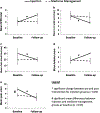Functional Improvements Utilizing the Short Physical Performance Battery (SPPB) in the Elderly after Epidural Steroid Injections
- PMID: 30796532
- PMCID: PMC6766078
- DOI: 10.1007/s11916-019-0748-2
Functional Improvements Utilizing the Short Physical Performance Battery (SPPB) in the Elderly after Epidural Steroid Injections
Abstract
Purpose of review: The treatment of debilitating pain and loss of function secondary to lumbar stenosis is in high demand with the aging patient population. Options, including epidural steroid injections (ESIs) and medication therapy, are limited and it is unclear if they provide any functional improvements. In this prospective study, we evaluate functional outcomes in older adults with symptomatic lumbar stenosis treated with ESIs compared to those managed with medications by introducing the Short Physical Performance Battery (SPPB). Our study was IRB-approved and included 16 patients, 68 to 83 years old, with symptomatic back and radicular leg pain secondary to lumbar stenosis. Patients could elect to undergo a lumbar ESI (n = 11) or be treated via medication management (n = 5). Numeric pain score, SPPB score, and adverse events were measured and compared at baseline and a 1-month follow-up visit.
Recent findings: Statistically significant improvements were observed from baseline compared to the 1-month follow-up for total SPPB score in the injection group. Similar improvements in the injection group were observed for pain scores and the SPPB subcomponents such as the 4-m walk test, chair stand time, and balance score. Comparatively, no statistically significant improvements were observed in the medication group. Lumbar ESIs improved objective physical capacity parameters and pain scores in elderly patients with symptomatic lumbar stenosis compared to medication management. In addition, the SPPB is an easy-to-use tool to measure changes in physical function in older adults and could easily be integrated into an outpatient pain clinic.
Keywords: Elderly; Epidural steroid injections; Lumbar stenosis and radicular pain; Short physical performance battery (SPPB).
Conflict of interest statement
Conflict of interest: Each author certifies that he or she, or a member of his or her immediate family, has no commercial association (i.e., consultancies, stock ownership, equity interest, patent/licensing arrangements, etc.) that might pose a conflict of interest in connection with the submitted manuscript.
Figures


Similar articles
-
MiDAS ENCORE: Randomized Controlled Study Design and Protocol.Pain Physician. 2015 Jul-Aug;18(4):307-16. Pain Physician. 2015. PMID: 26218933 Clinical Trial.
-
Transforaminal epidural steroid injection via a preganglionic approach for lumbar spinal stenosis and lumbar discogenic pain with radiculopathy.Neurol India. 2010 Mar-Apr;58(2):248-52. doi: 10.4103/0028-3886.63807. Neurol India. 2010. PMID: 20508344
-
Outcome Measurements for Pain Relief in Elderly Patients with Spinal Stenosis Undergoing Epidural Steroid Injection: Is Conservative Approach an Option?Turk Neurosurg. 2020;30(5):734-738. doi: 10.5137/1019-5149.JTN.29251-20.3. Turk Neurosurg. 2020. PMID: 32530487
-
Epidural injections with or without steroids in managing chronic low back pain secondary to lumbar spinal stenosis: a meta-analysis of 13 randomized controlled trials.Drug Des Devel Ther. 2015 Aug 13;9:4657-67. doi: 10.2147/DDDT.S85524. eCollection 2015. Drug Des Devel Ther. 2015. PMID: 26316704 Free PMC article. Review.
-
Comparison of Clinical Efficacy of Epidural Injection With or Without Steroid in Lumbosacral Disc Herniation: A Systematic Review and Meta-analysis.Pain Physician. 2018 Sep;21(5):449-468. Pain Physician. 2018. PMID: 30282390
Cited by
-
Wearable-Based Stair Climb Power Estimation and Activity Classification.Sensors (Basel). 2022 Sep 1;22(17):6600. doi: 10.3390/s22176600. Sensors (Basel). 2022. PMID: 36081058 Free PMC article.
-
Physical Performance, Body Composition, and Oral Health in Community-Residing Older Adults: A Cross-Sectional Study.Geriatrics (Basel). 2024 Jun 26;9(4):89. doi: 10.3390/geriatrics9040089. Geriatrics (Basel). 2024. PMID: 39051253 Free PMC article.
-
Physical Competence, Physical Well-Being, and Perceived Physical Literacy among Older Adults in Day Care Centers of Hong Kong.Int J Environ Res Public Health. 2022 Mar 24;19(7):3851. doi: 10.3390/ijerph19073851. Int J Environ Res Public Health. 2022. PMID: 35409534 Free PMC article.
-
Assessing the feasibility of using the short physical performance battery to measure function in the immediate postoperative period after total knee replacement.Eur J Transl Myol. 2021 Apr 7;31(2):9673. doi: 10.4081/ejtm.2021.9673. Eur J Transl Myol. 2021. PMID: 33840178 Free PMC article.
-
Beyond the Back: The Science of Lumbar Epidural Steroid Injections.J Orthop Case Rep. 2024 Jul;14(7):6-10. doi: 10.13107/jocr.2024.v14.i07.4554. J Orthop Case Rep. 2024. PMID: 39035395 Free PMC article. No abstract available.
References
-
- Kovacs FM, Urrútia G, Alarcón JD. Surgery versus conservative treatment for symptomatic lumbar spinal stenosis: A systematic review of randomized controlled trials. Spine. 2011; 36:E1335–1351. - PubMed
-
- Issack PS, Cunningham ME, Pumberger M, Hughes AP, Cammisa FP. Degenerative lumbar spinal stenosis: Evaluation and management. J Am Acad Orthop Surg. 2012;20:527–535. - PubMed
-
- Borenstein D. Mechanical low back pain: a rheumatologist’s view. Nat Rev Rheumatol. 2013;9:643–653. - PubMed
-
- Kreiner SD, Shaffer WO, Baisden JL, Gilbert TJ, Summers JT, Toton JF, Hwang SW, Mendel RC, Reitman CA; North American Spine Society. An evidence-based clinical guideline for the diagnosis and treatment of degenerative lumbar spinal stenosis (update). Spine J. 2013;13:734–743. - PubMed
Publication types
MeSH terms
Substances
Grants and funding
LinkOut - more resources
Full Text Sources
Medical
Research Materials

